Central Bulge Ferrite Core for Efficient Wireless Power Transfer
Abstract
:1. Introduction
2. Efficiency Analysis for the Planar Core and the Central Bulge Ferrite Cores
2.1. Influence of Mutual Inductance on WPT System Efficiency
2.2. Mutual Inductance Calculation for Central Bulge Ferrite Core
2.2.1. Mutual Inductance Calculation of Planar Core
2.2.2. Mutual Inductance Calculation of the Central Bulge Ferrite Core
2.2.3. Comparative Analysis
3. Parameter Design
4. Simulation Comparison
5. Experimental Verification
- (1)
- The theoretical analysis does not consider the case where the impedance mismatch causes the input impedance to increase. In case of short-distance transmission, the WPT system works in the over-coupled region and there is frequency splitting.
- (2)
- The self-inductance and mutual inductance of the magnetic coupling structure are increased with the proposed core, but the compensation capacitance of the system does not change, which leads to system mismatch, resulting in the first half of the efficiency drop, and the best matching point is shifted.
- (3)
- The theoretical analysis and simulation does not include the core loss of the core. Due to the increase in the volume of the core portion, the magnetic loss of the magnetic coupling system may increase, resulting in a decrease of efficiency in the first half.
6. Conclusions
Author Contributions
Funding
Institutional Review Board Statement
Informed Consent Statement
Data Availability Statement
Acknowledgments
Conflicts of Interest
Appendix A
References
- Jiang, Y.; Wang, L.; Wang, Y. Analysis, Design and Implementation of Accurate ZVS Angle Control for EV Battery Charging in Wireless High Power Transfer. IEEE Trans. Ind. Electron. 2019, 60, 4075–4085. [Google Scholar] [CrossRef]
- Choi, S.Y.; Gu, B.W.; Jeong, S.Y. Modern Advances in Wireless Power Transfer Systems for Roadway Powered Electric Vehicles. IEEE Trans. Ind. Electron. 2016, 63, 6533–6545. [Google Scholar]
- Liu, C.; Jiang, C.; Song, J.; Chau, K.T. An Effective Sandwiched Wireless Power Transfer System for Charging Implantable Cardiac Pacemaker. IEEE Trans. Ind. Electron. 2019, 66, 4108–4117. [Google Scholar] [CrossRef]
- Olatinwo, S.O.; Joubert, T.H. Energy Efficient Solutions in Wireless Sensor Systems for Water Quality Monitoring: A Review. IEEE Sens. J. 2019, 19, 1596–1625. [Google Scholar] [CrossRef]
- Zhou, J.; Zhang, B.; Xiao, W.; Qiu, D. Nonlinear Parity-Time-Symmetric Model for Constant Efficiency Wireless Power Transfer: Application to a Drone-in-Flight Wireless Charging Platform. IEEE Trans. Ind. Electron. 2019, 66, 4097–4107. [Google Scholar] [CrossRef]
- Basar, M.R.; Ahmad, M.Y.; Cho, J. Stable and High-Efficiency Wireless Power Transfer System for Robotic Capsule Using a Modified Helmholtz Coil. IEEE Trans. Ind. Electron. 2017, 64, 1113–1122. [Google Scholar] [CrossRef]
- Hui, S.Y.R.; Zhong, W.; Lee, C.K. A Critical Review of Recent Progress in Mid-Range Wireless Power Transfer. IEEE Trans. Power Electron. 2014, 29, 4500–4511. [Google Scholar] [CrossRef] [Green Version]
- Mayordomo, I.; Dräger, T.; Spies, P. An Overview of Technical Challenges and Advances of Inductive Wireless Power Transmission. Proc. IEEE 2013, 101, 1302–1311. [Google Scholar] [CrossRef]
- Zhong, W.X.; Zhang, C.; Liu, X.; Hui, S.Y.R. A methodology for making a three-coil wireless power transfer system more energy efficient than a two-coil counterpart for extended transfer distance. IEEE Trans. Power Electron. 2016, 30, 933–942. [Google Scholar] [CrossRef]
- Ye, Z.H.; Sun, Y.; Dai, X.; Tang, C.S. Energy Efficiency Analysis of U-coil Wireless Power Transfer System. IEEE Trans. Power Electron. 2016, 31, 4809–4817. [Google Scholar] [CrossRef]
- Zhang, Z.; Pang, H.; Georgiadis, A. Wireless Power Transfer—An Overview. IEEE Trans. Ind. Electron. 2019, 66, 1044–1058. [Google Scholar] [CrossRef]
- Raju, S.; Wu, R.; Chan, M.; Yue, C.P. Modeling of Mutual Coupling Between Planar Inductors in Wireless Power Applications. IEEE Trans. Power Electron. 2014, 29, 481–490. [Google Scholar] [CrossRef]
- Waters, B.H.; Mahoney, B.J.; Lee, G. Optimal coil size ratios for wireless power transfer applications. In Proceedings of the 2014 IEEE International Symposium on Circuits and Systems (ISCAS), Melbourne, Australia, 1–5 June 2014; pp. 2045–2048. [Google Scholar]
- Cove, S.R.; Ordonez, M.; Shafiei, N. Improving Wireless Power Transfer Efficiency Using Hollow Windings with Track-Width-Ratio. IEEE Trans. Power Electron. 2016, 31, 6524–6533. [Google Scholar] [CrossRef]
- Jeong, S.Y.; Kwak, H.G.; Jang, G.C. Dual-Purpose Nonoverlapping Coil Sets as Metal Object and Vehicle Position Detections for Wireless Stationary EV Chargers. IEEE Trans. Power Electron. 2018, 33, 7387–7397. [Google Scholar] [CrossRef]
- Moon, S.C.; Moon, G.W. Wireless Power Transfer System with an Asymmetric 4-Coil Resonator for Electric Vehicle Battery Chargers. In Proceedings of the 2015 IEEE Applied Power Electronics Conference and Exposition (APEC), Charlotte, NC, USA, 15–19 March 2015; Volume 31, pp. 6844–6854. [Google Scholar]
- Lee, C.K.; Zhong, W.X.; Hui, S.Y.R. Effects of Magnetic Coupling of Nonadjacent Resonators on Wireless Power Domino-Resonator Systems. IEEE Trans. Power Electron. 2012, 27, 1905–1916. [Google Scholar] [CrossRef] [Green Version]
- Chen, L.; Liu, S.; Zhou, Y.C.; Cui, T.J. An Optimizable Circuit Structure for High-Efficiency Wireless Power Transfer. IEEE Trans. Ind. Electron. 2013, 60, 339–349. [Google Scholar] [CrossRef]
- Yeo, T.D.; Kwon, D.S.; Khang, S.T. Design of Maximum Efficiency Tracking Control Scheme for Closed Loop Wireless Power Charging System Employing Series Resonant Tank. IEEE Trans. Power Electron. 2017, 32, 471–478. [Google Scholar] [CrossRef]
- Kim, H.; Song, C.; Kim, D.H.; Jung, D.H. Coil Design and Measurements of Automotive Magnetic Resonant Wireless Charging System for High-Efficiency and Low Magnetic Field Leakage. IEEE Trans. Microw. Theory Tech. 2016, 64, 383–400. [Google Scholar] [CrossRef]
- Li, Z.; Zhu, C.; Jiang, J.; Song, K. A 3 kW Wireless Power Transfer System for Sightseeing Car Supercapacitor Charge. IEEE Trans. Power Electron. 2017, 32, 3301–3316. [Google Scholar] [CrossRef]
- Budhia, M.; Covic, G.A.; Boys, J.T. Design and Optimization of Circular Magnetic Structures for Lumped Inductive Power Transfer Systems. IEEE Trans. Power Electron. 2011, 26, 3096–3108. [Google Scholar] [CrossRef]
- Mohammad, M.; Choi, S.; Islam, Z. Core Design and Optimization for Better Misalignment Tolerance and Higher Range Wireless Charging of PHEV. IEEE Trans. Transp. Electrif. 2017, 3, 445–453. [Google Scholar] [CrossRef]
- Wang, M.; Feng, J.; Shi, Y.; Shen, M. Demagnetization Weakening and Magnetic Field Concentration With Ferrite Core Characterization for Efficient Wireless Power Transfer. IEEE Trans. Ind. Electron. 2019, 66, 1842–1851. [Google Scholar] [CrossRef]
- Luo, Y. Field and inductance calculations for coaxial circular coils with magnetic cores of finite length and constant permeability. IET Electr. Power Appl. 2017, 11, 1254–1264. [Google Scholar] [CrossRef]
- Lubin, T.; Berger, K.; Rezzoug, A. Inductance and force calculation for axisymmetric coil systems including an iron core of finite length. Prog. Electromagn. Res. 2012, 41, 377–396. [Google Scholar] [CrossRef] [Green Version]
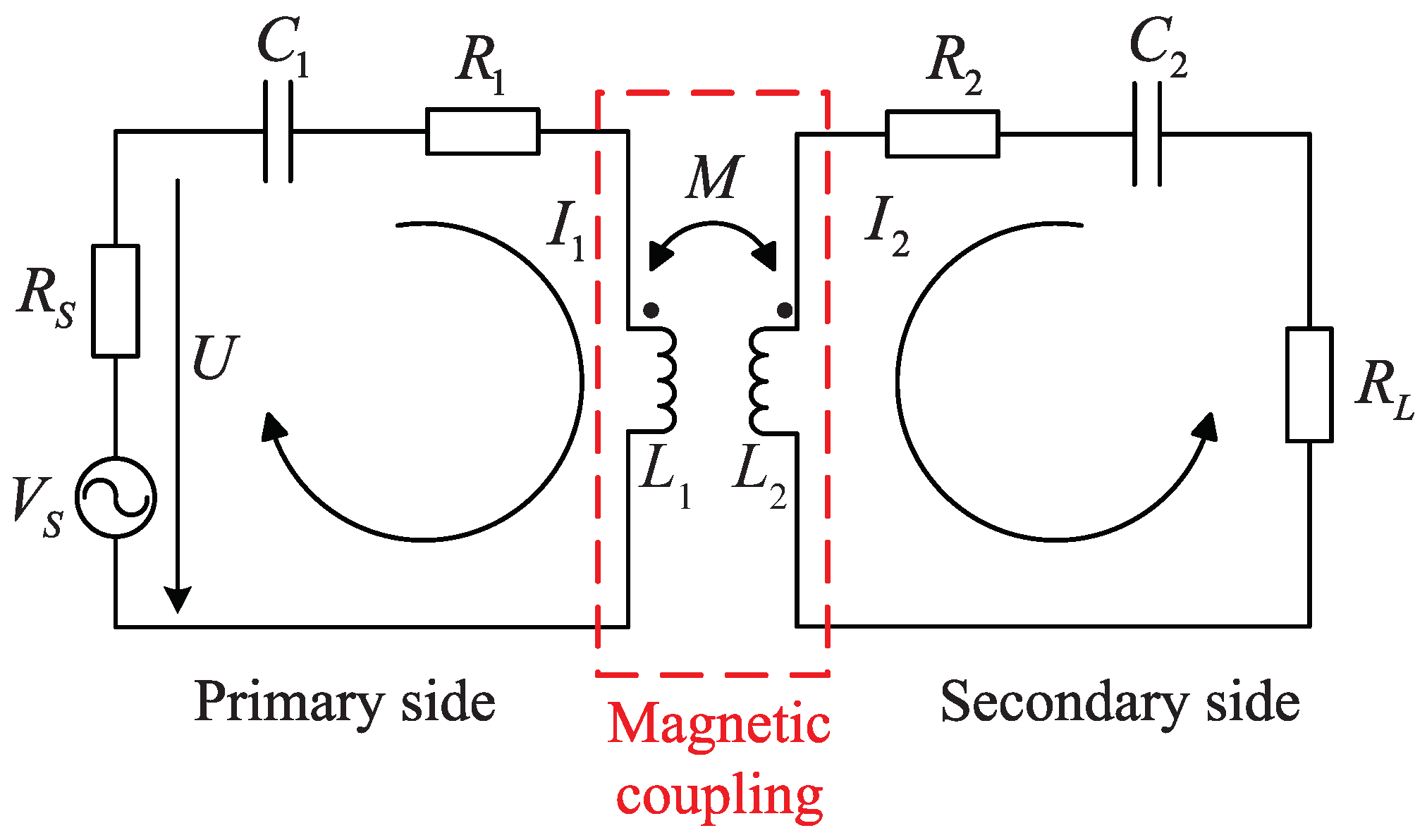
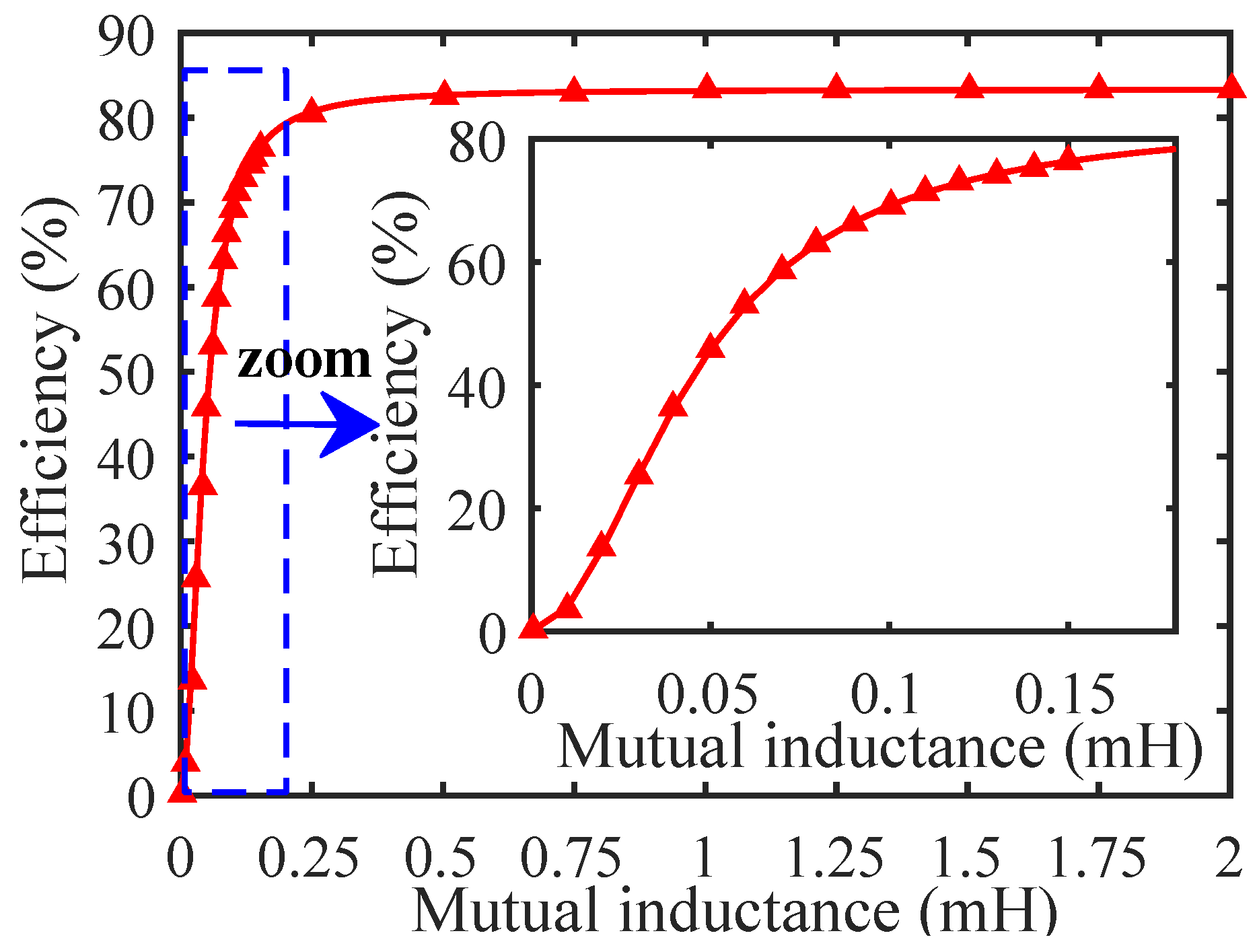


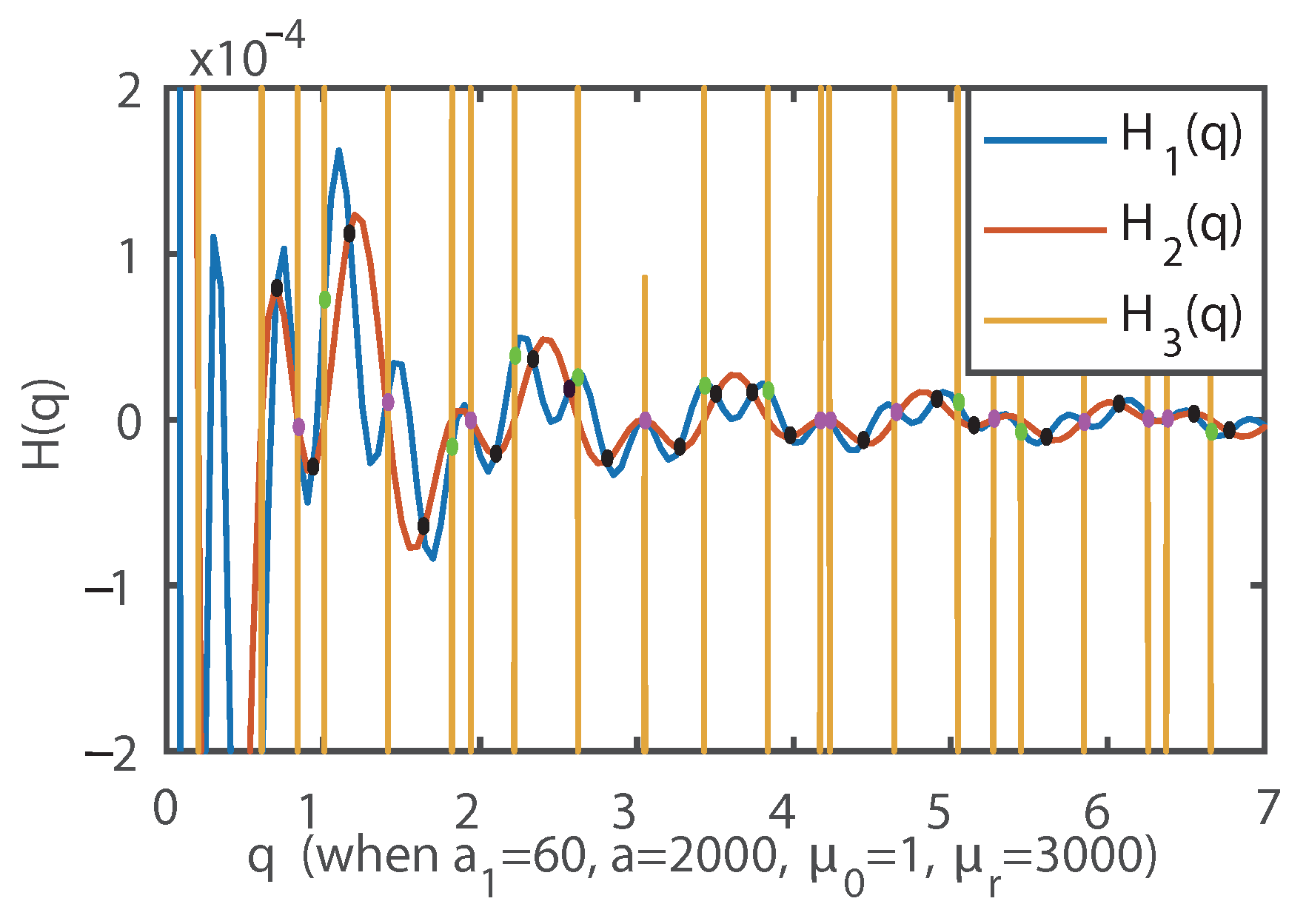
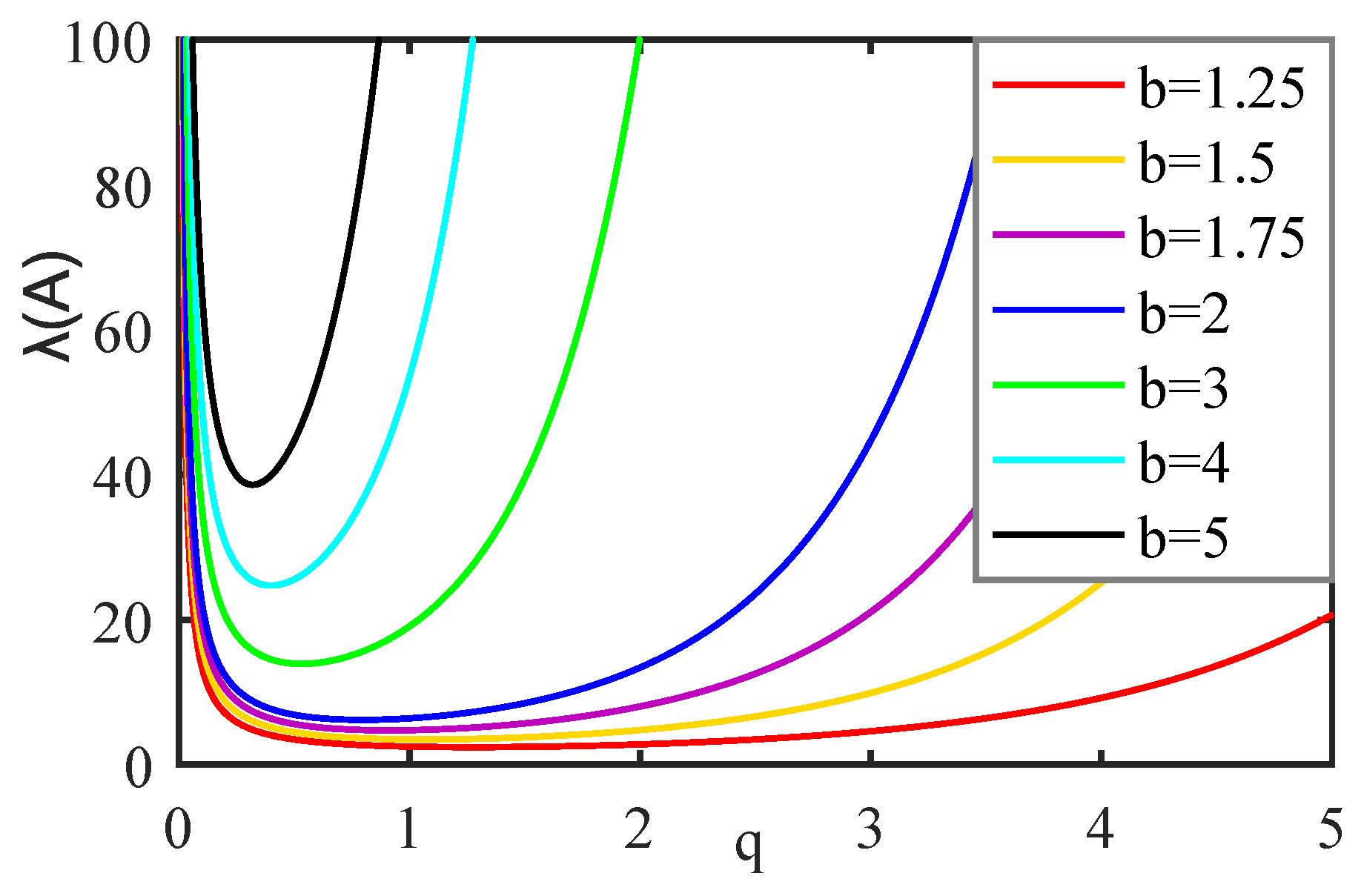



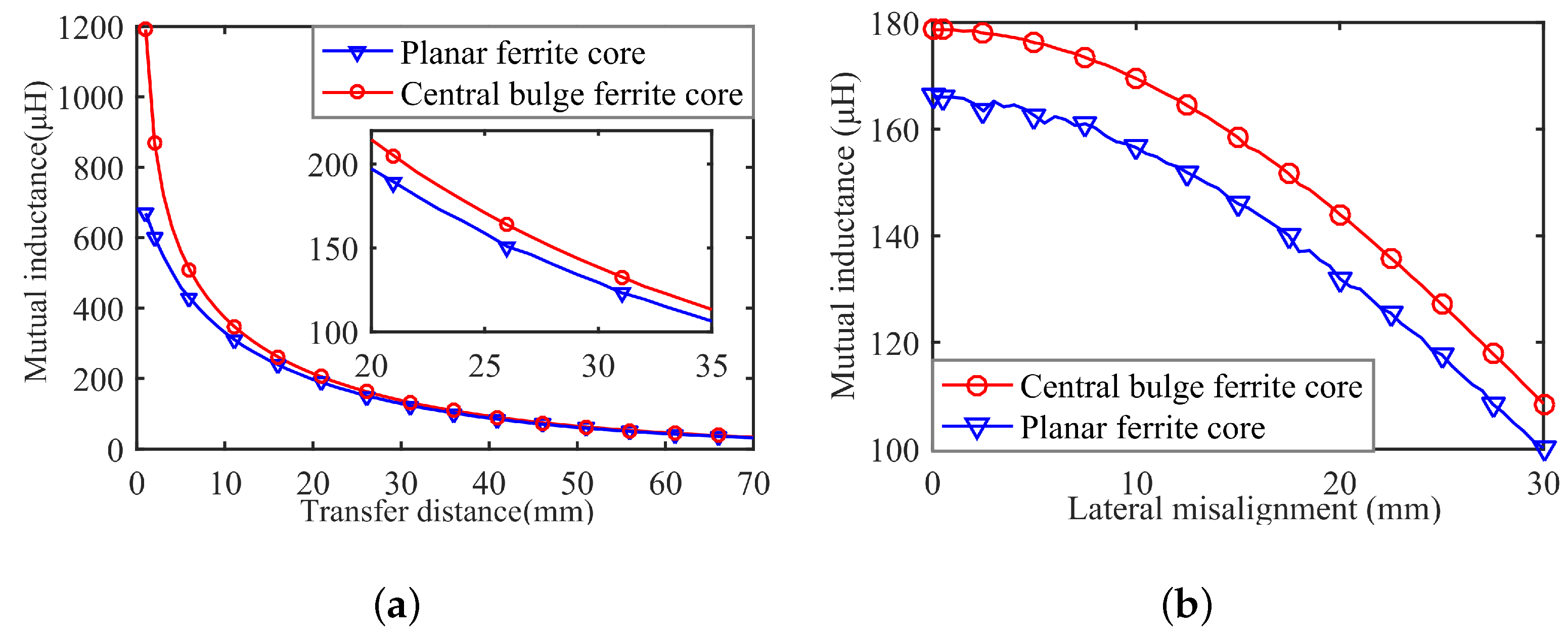
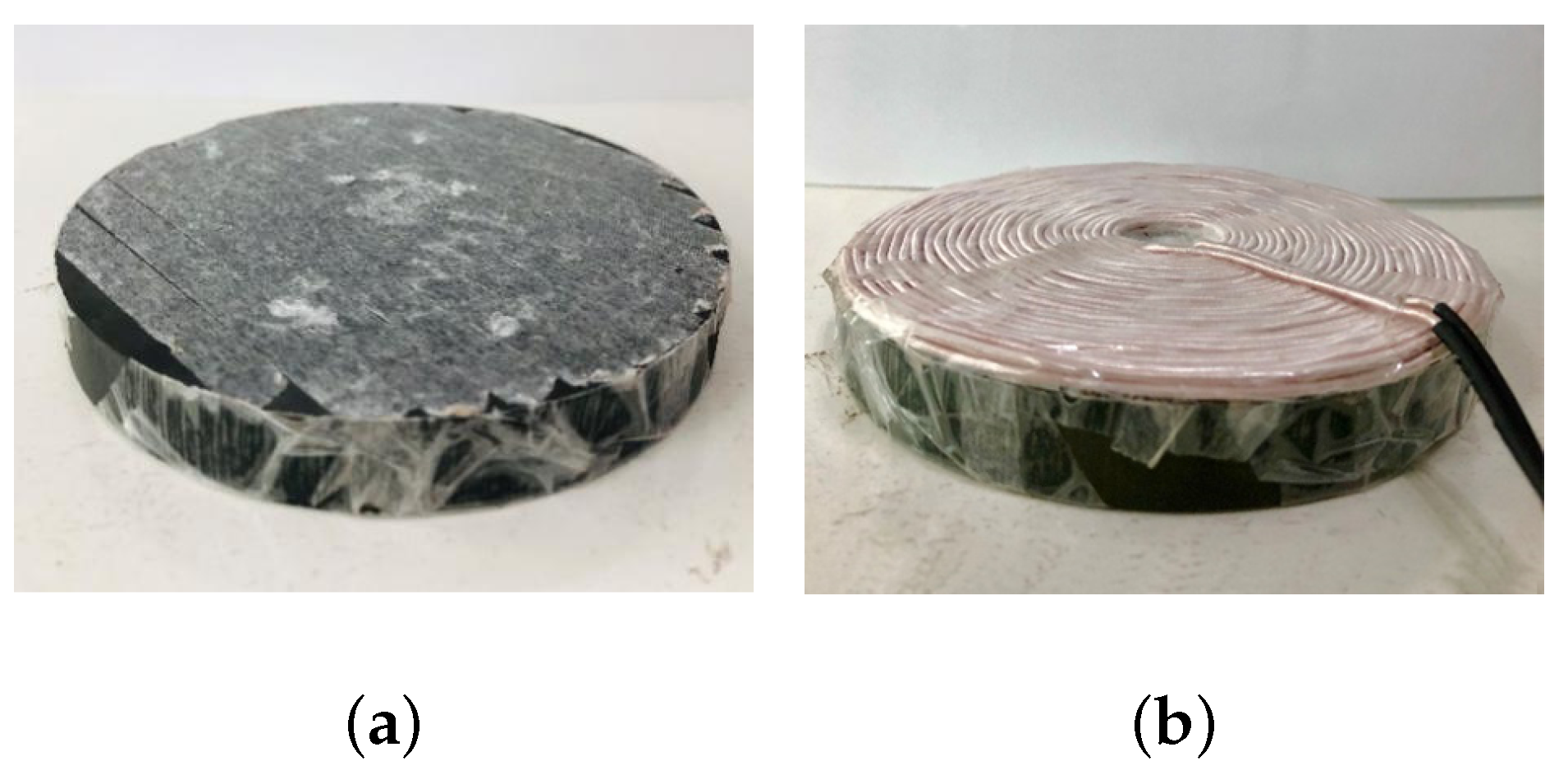
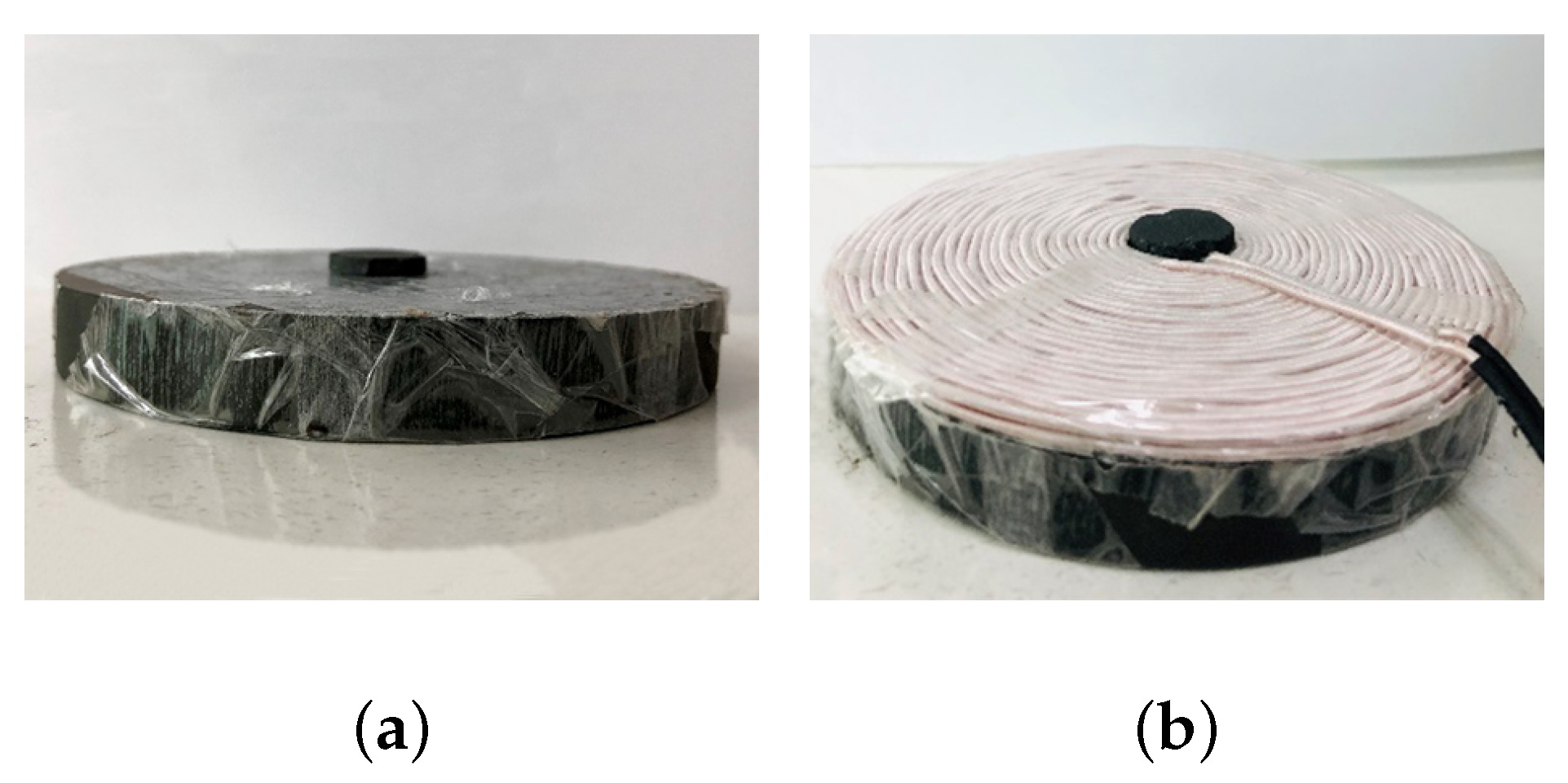
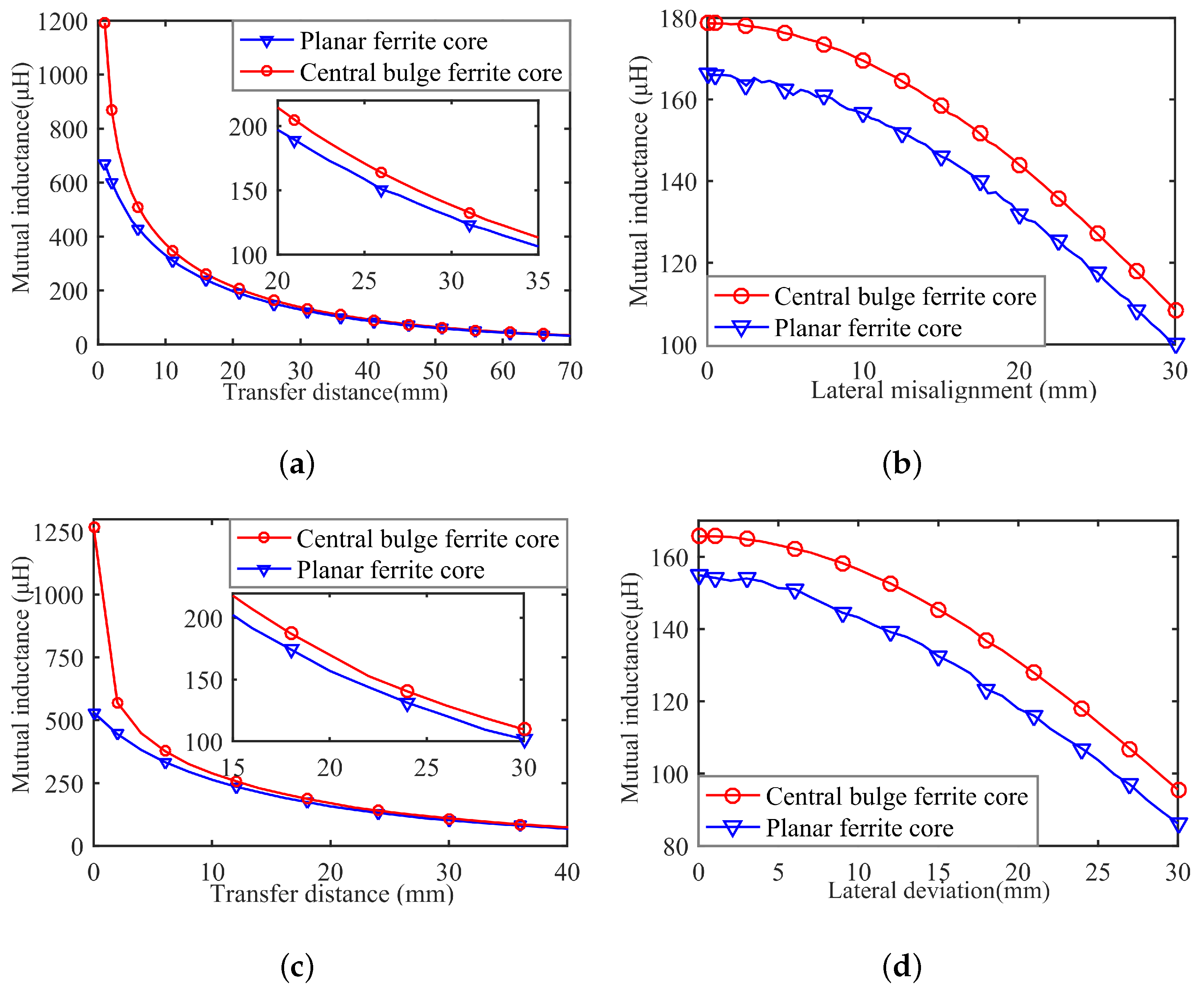
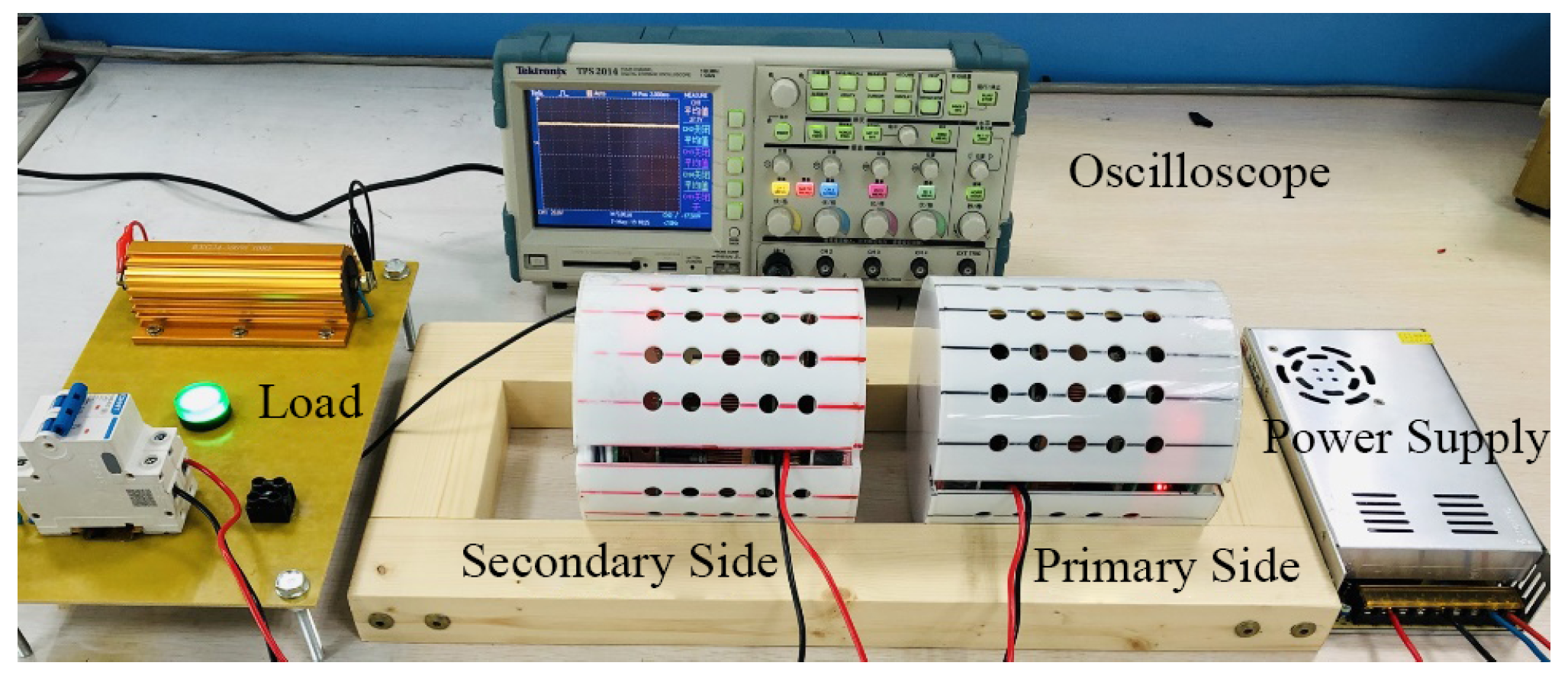


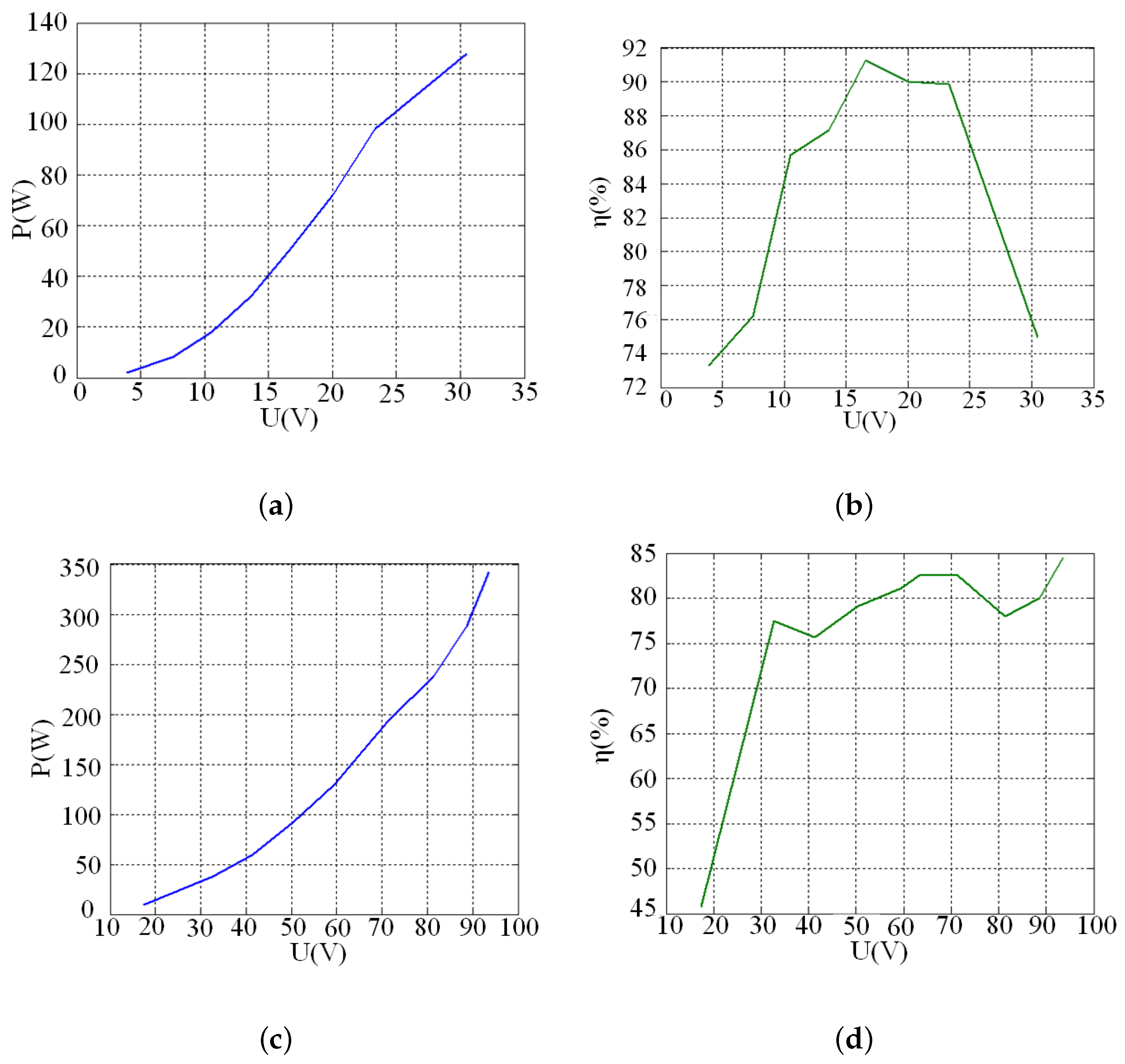
| Structure Parameters | Size/mm |
|---|---|
| The total thickness of magnetic coupling structure (H) | 10 |
| Core radius () | 60 |
| Transmission distance (d) | 24 |
| Coil outer diameter (R) | 60 |
| Coil inner diameter (r) | 10 |
| Coil Layer | uH | uH | uH | k |
|---|---|---|---|---|
| 1 | 94.4490 | 94.4205 | 48.5675 | 0.5143 |
| 2 | 357.7960 | 357.5945 | 173.1404 | 0.4840 |
| 3 | 772.4861 | 772.4096 | 353.3836 | 0.4575 |
| Optimized Parameter | Size/mm |
|---|---|
| The total thickness of magnetic coupling structure (H) | 10 |
| Core radius () | 60 |
| Height of intermediate bulge (h) | 3.4 |
| Transmission distance (d) | 24 |
| Coil outer diameter (R) | 60 |
| Coil inner diameter (r) | 10 |
| Structure Parameter | Size/mm |
|---|---|
| Total thickness of magnetic coupling structure (H) | 10 |
| Core radius () | 60 |
| Coil thickness (h) | 3.4 |
| Transmission distance (d) | 24 |
| Coil outer diameter (R) | 60 |
| Coil inner diameter (r) | 10 |
Publisher’s Note: MDPI stays neutral with regard to jurisdictional claims in published maps and institutional affiliations. |
© 2021 by the authors. Licensee MDPI, Basel, Switzerland. This article is an open access article distributed under the terms and conditions of the Creative Commons Attribution (CC BY) license (https://creativecommons.org/licenses/by/4.0/).
Share and Cite
Xu, H.; Song, H.; Hou, R. Central Bulge Ferrite Core for Efficient Wireless Power Transfer. Energies 2021, 14, 5111. https://doi.org/10.3390/en14165111
Xu H, Song H, Hou R. Central Bulge Ferrite Core for Efficient Wireless Power Transfer. Energies. 2021; 14(16):5111. https://doi.org/10.3390/en14165111
Chicago/Turabian StyleXu, Huabo, Huihui Song, and Rui Hou. 2021. "Central Bulge Ferrite Core for Efficient Wireless Power Transfer" Energies 14, no. 16: 5111. https://doi.org/10.3390/en14165111
APA StyleXu, H., Song, H., & Hou, R. (2021). Central Bulge Ferrite Core for Efficient Wireless Power Transfer. Energies, 14(16), 5111. https://doi.org/10.3390/en14165111







